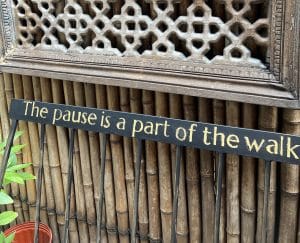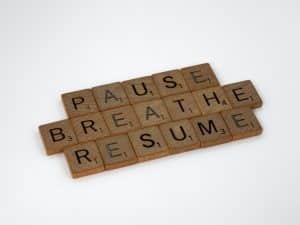
Remember when you were in grade school, and when the teacher would take attendance you had the choice of saying “here” or “present”? As a second or third-grader, it was about the only choice anyone ever gave us, so it was kind of cool. Or, it would have been, if it weren’t for the fact that I didn’t really understand what “present” meant, and never used it. I thought it was some sort of alternate declaration – about what I wasn’t sure – so I stuck with “here,” even though it turns out “present” meant the same thing. Which is why I’m feeling a little justified as I write this today, because now, of course, we know that they aren’t the same at all.
You can be physically “here,” but not present at all. We all know what it’s like to interact with someone who is “somewhere else.” You may be looking right at them, and they may even be looking back at you, but mentally, they aren’t with you. That lack of connection can be mildly annoying or downright devastating, depending on the circumstances. Sometimes, however, we check out simply by not fully checking in. We may not be daydreaming, but we are holding back. For any number of reasons (anxiety, fear, self-doubt, etc.), we aren’t bringing the full weight of our strengths, capabilities and beliefs to the interaction or endeavor. We may really, truly, even desperately want to be present, but as I (with the help of R.W. Emerson) reflected earlier this week, we get in our own way.
Mindfulness can help us work through those roadblocks. The whole purpose of the effort is to bring our attention out of the past and future and into the present moment. Doing so makes us present in that moment, as we work to become less distracted by thoughts and other stimuli, and more aware of our internal responses and external demeanor. We see our negative thoughts and feelings for what they are – passing experiences that do not define us. As a result, we are capable of being more engaged, more intentionally responsive – more present – in our actions and interactions, even (perhaps especially) in demanding situations.
A few years ago, Harvard Business School professor Amy Cuddy gave a TED Talk that I routinely use in my coaching. Apparently, I’m not the only person who saw it (It has over 32 million total views), and she has since become known the world over as an expert in body language, and specifically, “power posing.” Given how much I love the talk, and how meaningful her findings and recommendations have been for people I’ve worked with, I couldn’t have been more excited to read her latest book, Presence. I mean, the title alone tells you we’re going to have a lot to talk about, right? Yes! Well, according to Cuddy, maybe no, but after reading the book, according to me, YES.
So here’s the rub: Cuddy explicitly says that the book isn’t about mindfulness (p. 25), but thing is…it is. Mindfulness isn’t about creating a “lasting crystalline awareness” that removes us from the reality of our daily lives, as she references, but rather, it’s about connecting us deeply to them in a way that brings our full selves into them. Cuddy’s message in Presence and the practice of mindfulness share similar goals. Our conversations on this blog about how mindfulness can help you be a better interviewer, diffuse difficult people and situations, or manage the creative stylings of your internal storyteller/anxiety producer are echoed throughout Presence. Turns out, being present is a key indicator of being successful.
At one point, Cuddy addresses the role a fundamental building block of mindfulness plays in creating presence: “The tools we need to become present are built into our biology. One of them is an action so basic we usually forget we’re dong it: breathing” (p. 181). Yes, breathing! Sound familiar? Connecting to our bodies is central to a mindfulness practice, whether through breath or movement (or both, as with yoga). What’s interesting about Cuddy’s work is how she takes this awareness one step further, considering how manipulating our bodies can serve to enhance our confidence and performance, especially when we’re anxious. She cites research (hers and others’) that supports the idea that it is possible to not only appear more capable, likeable, and perhaps most critically, trustworthy to others, but to make yourself feel that you embody these qualities through striking “power poses.” In some cases, even just imagining that you’re doing so can work. Amazing stuff.
Amidst the many areas in Presence where Cuddy’s assertions align with mindfulness, one is particularly meaningful. At the root of any positive outcome you may experience – from intentionally strengthening your body language to simply breathing mindfully, being present makes you powerful. In turn, “…feeling powerful synchronizes our thoughts, feelings and behaviors, bringing us closer to presence” (p. 125). It’s a delightfully self-supporting circle. The ability to fully inhabit your body and mind – your full self – and to be comfortable in them dramatically changes how you view challenges, and how you respond to them. It changes how people view you, and how you view yourself.
If that’s not powerful, I don’t know what is. And to think, it’s all already within you.
Photo credit: Chris Rief (The Red Chair series)




3 thoughts on “Here, or present?”
Yup, presence feels great.I also teach presence – as a wonderful awareness of the bigger us, the sense of something other that cannot be held or controlled so that surrender ( scary for so many) is the gateway to those daily glimpses.
http://www.innerbodywisdom.co.uk
“Surrender” is a great word, Frances! There is a risk with letting yourself be big, so to speak, but so very worth it when you realize the potential it has opened. Thanks very much for sharing your experience as a teacher as well!
Pingback: No-Fail Friday: Such a poser | MindfulMBA